Remote Estimation of Above-Ground Biomass Throughout the Entire Growth Period for Crops with Conspicuous Spikes
Abstract
1. Introduction
2. Materials and Methods
2.1. Study Area
2.2. AGB Measurements
2.3. Manual Determination of Heading Date in Crop
2.4. Canopy Hyperspectral Reflectance Retrieved from ASD
2.5. UAV-Based Data Collection
2.5.1. RGB Image
2.5.2. Multispectral Image
2.6. Features Derived from Remote Sensing Data
2.6.1. VI
2.6.2. Spectral Absorption Characteristics Parameter
2.6.3. Canopy Height
2.7. Analysis Methods
2.7.1. AGB Estimation Based on VI and Canopy Height
2.7.2. Multiple Linear Regression
2.7.3. Random Forest Regression
2.7.4. Support Vector Regression
3. Results
3.1. AGB Estimation Performance in Two Stages
3.2. Adding Spectral Absorption Characteristic Parameter After Heading
4. Discussion
5. Conclusions
Author Contributions
Funding
Data Availability Statement
Acknowledgments
Conflicts of Interest
References
- Xu, T.Y.; Wang, F.M.; Xie, L.L.; Yao, X.P.; Zheng, J.Y.; Li, J.L.; Chen, S.T. Integrating the Textural and Spectral Information of UAV Hyperspectral Images for the Improved Estimation of Rice Aboveground Biomass. Remote Sens. 2022, 14, 2534. [Google Scholar] [CrossRef]
- Chen, Z.X.; Ren, J.Q.; Tang, H.J.; Shi, Y.; Len, P.; Liu, J.; Wang, L.M.; Wu, W.B.; Yao, Y.M.; Hasituya. Progress and prospect of agricultural remote sensing research and application. J. Remote Sens. 2016, 20, 748–767. [Google Scholar]
- Yang, S.X.; Feng, Q.S.; Liang, T.G.; Liu, B.K.; Zhang, W.J.; Xie, H.J. Modeling grassland above-ground biomass based on artificial neural network and remote sensing in the Three-River Headwaters Region. Remote Sens. Environ. 2018, 204, 448–455. [Google Scholar] [CrossRef]
- Yu, Y.; Pan, Y.; Yang, X.; Fan, W. Spatial Scale Effect and Correction of Forest Aboveground Biomass Estimation Using Remote Sensing. Remote Sens. 2022, 14, 2828. [Google Scholar] [CrossRef]
- Liu, Y.; Feng, H.; Yue, J.; Li, Z.; Jin, X.; Fan, Y.; Feng, Z.; Yang, G. Estimation of Aboveground Biomass of Potatoes Based on Characteristic Variables Extracted from UAV Hyperspectral Imagery. Remote Sens. 2022, 14, 5121. [Google Scholar] [CrossRef]
- Wocher, M.; Berger, K.; Verrelst, J.; Hank, T. Retrieval of carbon content and biomass from hyperspectral imagery over cultivated areas. ISPRS J. Photogramm. Remote Sens. 2022, 193, 104–114. [Google Scholar] [CrossRef] [PubMed]
- Musthafa, M.; Singh, G. Improving Forest Above-Ground Biomass Retrieval Using Multi-Sensor L- and C- Band SAR Data and Multi-Temporal Spaceborne LiDAR Data. Front. For. Glob. Chang. 2022, 5, 822704. [Google Scholar] [CrossRef]
- Santoro, M.; Cartus, O.; Wegmüller, U.; Besnard, S.; Carvalhais, N.; Araza, A.; Herold, M.; Liang, J.; Cavlovic, J.; Engdahl, M.E. Global estimation of above-ground biomass from spaceborne C-band scatterometer observations aided by LiDAR metrics of vegetation structure. Remote Sens. Environ. 2022, 279, 113114. [Google Scholar] [CrossRef]
- Quan, X.W.; He, B.B.; Yebra, M.; Yin, C.M.; Liao, Z.M.; Zhang, X.T.; Li, X. A radiative transfer model-based method for the estimation of grassland aboveground biomass. Int. J. Appl. Earth Obs. Geoinf. 2017, 54, 159–168. [Google Scholar] [CrossRef]
- Rotter, R.P.; Palosuo, T.; Kersebaum, K.C.; Angulo, C.; Bindi, M.; Ewert, F.; Ferrise, R.; Hlavinka, P.; Moriondo, M.; Nendel, C.; et al. Simulation of spring barley yield in different climatic zones of Northern and Central Europe: A comparison of nine crop models. Field Crops Res. 2012, 133, 23–36. [Google Scholar] [CrossRef]
- Kaur, S.; Singh, M. Modeling the crop growth—A review. Mausam 2020, 71, 103–114. [Google Scholar]
- Yuan, W.P.; Cai, W.W.; Xia, J.Z.; Chen, J.Q.; Liu, S.G.; Dong, W.J.; Merbold, L.; Law, B.; Arain, A.; Beringer, J.; et al. Global comparison of light use efficiency models for simulating terrestrial vegetation gross primary production based on the La Thuile database. Agric. For. Meteorol. 2014, 192, 108–120. [Google Scholar] [CrossRef]
- Zhang, L.; Gao, H.; Zhang, X. Combining Radiative Transfer Model and Regression Algorithms for Estimating Aboveground Biomass of Grassland in West Ujimqin, China. Remote Sens. 2023, 15, 2918. [Google Scholar] [CrossRef]
- Cheng, Z.Q.; Meng, J.H.; Jiang, J.F.; Wang, Y.; Fang, H.T.; Yu, L.H. Estimation of above-ground biomass of maize in late growing period based on WOFOST model and UAV data. J. Remote. Sens. 2020, 24, 1403–1418. [Google Scholar]
- Jones, J.W.; Hoogenboom, G.; Porter, C.H.; Boote, K.J.; Batchelor, W.D.; Hunt, L.A.; Wilkens, P.W.; Singh, U.; Gijsman, A.J.; Ritchie, J.T. The DSSAT cropping system model. Eur. J. Agron. 2003, 18, 235–265. [Google Scholar] [CrossRef]
- Lara, M.A.S.; Pedreira, C.G.S.; Boote, K.J.; Pedreira, B.C.; Moreno, L.S.B.; Alderman, P.D. Predicting Growth of Panicum maximum: An Adaptation of the CROPGRO-Perennial Forage Model. Agron. J. 2012, 104, 600–611. [Google Scholar] [CrossRef]
- Pedreira, B.C.; Pedreira, C.G.S.; Boote, K.J.; Lara, M.A.S.; Alderman, P.D. Adapting the CROPGRO perennial forage model to predict growth of Brachiaria brizantha. Field Crops Res. 2011, 120, 370–379. [Google Scholar] [CrossRef]
- Pequeno, D.N.L.; Pedreira, C.G.S.; Boote, K.J. Simulating forage production of Marandu palisade grass (Brachiaria brizantha) with the CROPGRO-Perennial Forage model. Crop Pasture Sci. 2014, 65, 1335–1348. [Google Scholar] [CrossRef]
- Sau, F.; Boote, K.J.; Bostick, W.M.; Jones, J.W.; Minguez, M.I. Testing and improving evapotranspiration and soil water balance of the DSSAT crop models. Agron. J. 2004, 96, 1243–1257. [Google Scholar] [CrossRef]
- Chen, J.S.; Huang, J.X.; Lin, H.; Pei, Z.Y. Rice yield estimation method based on remote sensing information and crop growth model assimilation. Sci. China Inf. Sci. 2010, 40, 173–183. [Google Scholar]
- de Wit, A.; Boogaard, H.; Fumagalli, D.; Janssen, S.; Knapen, R.; van Kraalingen, D.; Supit, I.; van der Wijngaart, R.; van Diepen, K. 25 years of the WOFOST cropping systems model. Agric. Syst. 2019, 168, 154–167. [Google Scholar] [CrossRef]
- Zhuo, W.; Fang, S.; Gao, X.; Wang, L.; Wu, D.; Fu, S.; Wu, Q.; Huang, J. Crop yield prediction using MODIS LAI, TIGGE weather forecasts and WOFOST model: A case study for winter wheat in Hebei, China during 2009–2013. Int. J. Appl. Earth Obs. Geoinf. 2022, 106, 102668. [Google Scholar] [CrossRef]
- Holzworth, D.P.; Huth, N.I.; Devoil, P.G.; Zurcher, E.J.; Herrmann, N.I.; McLean, G.; Chenu, K.; van Oosterom, E.J.; Snow, V.; Murphy, C.; et al. APSIM—Evolution towards a new generation of agricultural systems simulation. Environ. Model. Softw. 2014, 62, 327–350. [Google Scholar] [CrossRef]
- Asseng, S.; Keating, B.A.; Fillery, I.R.P.; Gregory, P.J.; Bowden, J.W.; Turner, N.C.; Palta, J.A.; Abrecht, D.G. Performance of the APSIM-wheat model in Western Australia. Field Crops Res. 1998, 57, 163–179. [Google Scholar] [CrossRef]
- Asseng, S.; van Keulen, H.; Stol, W. Performance and application of the APSIM Nwheat model in the Netherlands. Eur. J. Agron. 2000, 12, 37–54. [Google Scholar] [CrossRef]
- Keating, B.A.; Carberry, P.S.; Hammer, G.L.; Probert, M.E.; Robertson, M.J.; Holzworth, D.; Huth, N.I.; Hargreaves, J.N.G.; Meinke, H.; Hochman, Z.; et al. An overview of APSIM, a model designed for farming systems simulation. Eur. J. Agron. 2003, 18, 267–288. [Google Scholar] [CrossRef]
- Potter, C.S.; Randerson, J.T.; Field, C.B.; Matson, P.A.; Klooster, S.A. Terrestrial Ecosystem Production: A Process Model Based on Global Satellite and Surface Data. Glob. Biogeochem. Cycles 1993, 7, 811–841. [Google Scholar] [CrossRef]
- Raza, S.M.H.; Mahmood, S.A. Estimation of Net Rice Production through Improved CASA Model by Addition of Soil Suitability Constant ((h)over-bar alpha). Sustainability 2018, 10, 1788. [Google Scholar] [CrossRef]
- Liu, Z.Z.; Zhang, X.W.; Chen, Y.S.; Zhang, C.C.; Qin, F.; Zeng, H.W. Remote sensing estimation of regional winter wheat biomass based on CASA mode. Trans. Agric. Eng. 2017, 33, 225–233+315–316. [Google Scholar]
- Zhao, Y.; Mao, D.; Zhang, D.; Wang, Z.; Du, B.; Yan, H.; Qiu, Z.; Feng, K.; Wang, J.; Jia, M. Mapping Phragmites australis Aboveground Biomass in the Momoge Wetland Ramsar Site Based on Sentinel-1/2 Images. Remote Sens. 2022, 14, 694. [Google Scholar] [CrossRef]
- Goetz, S.J.; Prince, S.D.; Goward, S.N.; Thawley, M.M.; Small, J. Satellite remote sensing of primary production: An improved production efficiency modeling approach. Ecol. Model. 1999, 122, 239–255. [Google Scholar] [CrossRef]
- Darvishzadeh, R.; Skidmore, A.; Schlerf, M.; Atzberger, C. Inversion of a radiative transfer model for estimating vegetation LAI and chlorophyll in a heterogeneous grassland. Remote Sens. Environ. 2008, 112, 2592–2604. [Google Scholar] [CrossRef]
- Adeluyi, O.; Harris, A.; Verrelst, J.; Foster, T.; Claya, G.D. Estimating the phenological dynamics of irrigated rice leaf area index using the combination of PROSAIL and Gaussian Process Regression. Int. J. Appl. Earth Obs. Geoinf. 2021, 102, 102454. [Google Scholar] [CrossRef] [PubMed]
- Wang, Z.; He, L.; He, Z.; Wang, X.; Li, L.; Kang, G.; Bai, W.; Chen, X.; Zhao, Y.; Xiao, Y. Integrating the PROSAIL and SVR Models to Facilitate the Inversion of Grassland Aboveground Biomass: A Case Study of Zoigê Plateau, China. Remote Sens. 2024, 16, 1117. [Google Scholar] [CrossRef]
- Elshikha, D.E.M.; Hunsaker, D.J.; Waller, P.M.; Thorp, K.R.; Dierig, D.; Wang, G.; Cruz, V.M.V.; Katterman, M.E.; Bronson, K.F.; Wall, G.W.; et al. Estimation of direct-seeded guayule cover, crop coefficient, and yield using UAS-based multispectral and RGB data. Agric. Water Manag. 2022, 265, 107540. [Google Scholar] [CrossRef]
- Li, B.; Xu, X.; Zhang, L.; Han, J.; Bian, C.; Li, G.; Liu, J.; Jin, L. Above-ground biomass estimation and yield prediction in potato by using UAV-based RGB and hyperspectral imaging. ISPRS J. Photogramm. Remote Sens. 2020, 162, 161–172. [Google Scholar] [CrossRef]
- Yue, J.; Yang, G.; Tian, Q.; Feng, H.; Xu, K.; Zhou, C. Estimate of winter-wheat above-ground biomass based on UAV ultrahigh-ground-resolution image textures and vegetation indices. ISPRS J. Photogramm. Remote Sens. 2019, 150, 226–244. [Google Scholar] [CrossRef]
- Luo, S.; Jiang, X.; He, Y.; Li, J.; Jiao, W.; Zhang, S.; Xu, F.; Han, Z.; Sun, J.; Yang, J.; et al. Multi-dimensional variables and feature parameter selection for aboveground biomass estimation of potato based on UAV multispectral imagery. Front. Plant Sci. 2022, 13, 948249. [Google Scholar] [CrossRef]
- Xu, L.; Zhou, L.; Meng, R.; Zhao, F.; Lv, Z.; Xu, B.; Zeng, L.; Yu, X.; Peng, S. An improved approach to estimate ratoon rice aboveground biomass by integrating UAV-based spectral, textural and structural features. Precis. Agric. 2022, 23, 1276–1301. [Google Scholar] [CrossRef]
- Chen, P.F.; Wang, J.L.; Liao, X.Y.; Yin, F.; Chen, B.R.; Liu, R. Inversion of above-ground biomass of grassland in Hulunbuir based on remote sensing data from environmental disaster reduction satellites. J. Nat. Resour. 2010, 25, 1122–1131. [Google Scholar]
- Bao, Y.; Wei, G.; Gao, Z. Estimation of winter wheat biomass based on remote sensing data at various spatial and spectral resolutions. Front. Earth Sci. China 2009, 3, 118–128. [Google Scholar] [CrossRef]
- Mutanga, O.; Skidmore, A.K. Narrow band vegetation indices overcome the saturation problem in biomass estimation. Int. J. Remote Sens. 2004, 25, 3999–4014. [Google Scholar] [CrossRef]
- Fu, Y.Y.; Yang, G.J.; Wang, J.H.; Song, X.Y.; Feng, H.K. Winter wheat biomass estimation based on spectral indices, band depth analysis and partial least squares regression using hyperspectral measurements. Comput. Electron. Agric. 2014, 100, 51–59. [Google Scholar] [CrossRef]
- Thenkabail, P.S.; Smith, R.B.; De Pauw, E. Hyperspectral vegetation indices and their relationships with agricultural crop characteristics. Remote Sens. Environ. 2000, 71, 158–182. [Google Scholar] [CrossRef]
- Feng, H.; Fan, Y.; Yue, J.; Bian, M.; Liu, Y.; Chen, R.; Ma, Y.; Fan, J.; Yang, G.; Zhao, C. Estimation of potato above-ground biomass based on the VGC-AGB model and deep learning. Comput. Electron. Agric. 2025, 232, 110122. [Google Scholar] [CrossRef]
- Duan, B.; Liu, Y.; Gong, Y.; Peng, Y.; Wu, X.; Zhu, R.; Fang, S. Remote estimation of rice LAI based on Fourier spectrum texture from UAV image. Plant Methods 2019, 15, 124. [Google Scholar] [CrossRef] [PubMed]
- Freitas, R.G.; Pereira, F.R.S.; Dos Reis, A.A.; Magalhães, P.S.G.; Figueiredo, G.K.D.A.; do Amaral, L.R. Estimating pasture aboveground biomass under an integrated crop-livestock system based on spectral and texture measures derived from UAV images. Comput. Electron. Agric. 2022, 198, 107122. [Google Scholar] [CrossRef]
- Lu, D.; Batistella, M. Exploring TM image texture and its relationships with biomass estimation in Rondônia, Brazilian Amazon. Acta Amaz. 2005, 35, 249–257. [Google Scholar] [CrossRef]
- Nichol, J.E.; Sarker, M.L.R. Improved Biomass Estimation Using the Texture Parameters of Two High-Resolution Optical Sensors. IEEE Trans. Geosci. Remote Sens. 2011, 49, 930–948. [Google Scholar] [CrossRef]
- Fu, Y.Y.; Yang, G.J.; Li, Z.H.; Song, X.Y.; Li, Z.H.; Xu, X.G.; Wang, P.; Zhao, C.J. Winter Wheat Nitrogen Status Estimation Using UAV-Based RGB Imagery and Gaussian Processes Regression. Remote Sens. 2020, 12, 3778. [Google Scholar] [CrossRef]
- Fu, Y.Y.; Yang, G.J.; Song, X.Y.; Li, Z.H.; Xu, X.G.; Feng, H.K.; Zhao, C.J. Improved Estimation of Winter Wheat Aboveground Biomass Using Multiscale Textures Extracted from UAV-Based Digital Images and Hyperspectral Feature Analysis. Remote Sens. 2021, 13, 581. [Google Scholar] [CrossRef]
- Liu, J.; Zhu, Y.; Song, L.; Su, X.; Li, J.; Zheng, J.; Zhu, X.; Ren, L.; Wang, W.; Li, X. Optimizing window size and directional parameters of GLCM texture features for estimating rice AGB based on UAVs multispectral imagery. Front. Plant Sci. 2023, 14, 1284235. [Google Scholar] [CrossRef]
- Jimenez-Berni, J.A.; Deery, D.M.; Rozas-Larraondo, P.; Condon, A.G.; Rebetzke, G.J.; James, R.A.; Bovill, W.D.; Furbank, R.T.; Sirault, X.R.R. High Throughput Determination of Plant Height, Ground Cover, and Above-Ground Biomass in Wheat with LiDAR. Front. Plant Sci. 2018, 9, 237. [Google Scholar] [CrossRef] [PubMed]
- Tilly, N.; Aasen, H.; Bareth, G. Fusion of Plant Height and Vegetation Indices for the Estimation of Barley Biomass. Remote Sens. 2015, 7, 11449–11480. [Google Scholar] [CrossRef]
- Yue, J.B.; Feng, H.K.; Jin, X.L.; Yuan, H.H.; Li, Z.H.; Zhou, C.Q.; Yang, G.J.; Tian, Q.J. A Comparison of Crop Parameters Estimation Using Images from UAV-Mounted Snapshot Hyperspectral Sensor and High-Definition Digital Camera. Remote Sens. 2018, 10, 1138. [Google Scholar] [CrossRef]
- Navarro, J.A.; Algeet, N.; Fernandez-Landa, A.; Esteban, J.; Rodriguez-Noriega, P.; Guillen-Climent, M.L. Integration of UAV, Sentinel-1, and Sentinel-2 Data for Mangrove Plantation Aboveground Biomass Monitoring in Senegal. Remote Sens. 2019, 11, 77. [Google Scholar] [CrossRef]
- Meiyan, S.; Mengyuan, S.; Qizhou, D.; Xiaohong, Y.; Baoguo, L.; Yuntao, M. Estimating the maize above-ground biomass by constructing the tridimensional concept model based on UAV-based digital and multi-spectral images. Field Crops Res. 2022, 282, 108491. [Google Scholar] [CrossRef]
- Liu, Y.; Feng, H.; Yue, J.; Jin, X.; Fan, Y.; Chen, R.; Bian, M.; Ma, Y.; Li, J.; Xu, B.; et al. Improving potato AGB estimation to mitigate phenological stage impacts through depth features from hyperspectral data. Comput. Electron. Agric. 2024, 219, 108808. [Google Scholar] [CrossRef]
- Liu, Y.; Feng, H.; Yue, J.; Jin, X.; Fan, Y.; Chen, R.; Bian, M.; Ma, Y.; Song, X.; Yang, G. Improved potato AGB estimates based on UAV RGB and hyperspectral images. Comput. Electron. Agric. 2023, 214, 108260. [Google Scholar] [CrossRef]
- Liu, T.; Wang, J.; Wang, J.; Zhao, Y.; Wang, H.; Zhang, W.; Yao, Z.; Liu, S.; Zhong, X.; Sun, C. Research on the estimation of wheat AGB at the entire growth stage based on improved convolutional features. J. Integr. Agric. 2025, 24, 1403–1423. [Google Scholar] [CrossRef]
- Gnyp, M.L.; Miao, Y.; Yuan, F.; Ustin, S.L.; Yu, K.; Yao, Y.; Huang, S.; Bareth, G. Hyperspectral canopy sensing of paddy rice aboveground biomass at different growth stages. Field Crops Res. 2014, 155, 42–55. [Google Scholar] [CrossRef]
- Xu, T.; Wang, F.; Shi, Z.; Xie, L.; Yao, X. Dynamic estimation of rice aboveground biomass based on spectral and spatial information extracted from hyperspectral remote sensing images at different combinations of growth stages. ISPRS J. Photogramm. Remote Sens. 2023, 202, 169–183. [Google Scholar] [CrossRef]
- Rouse, J.W.; Haas, R.H.; Schell, J.A.; Deering, D.W. Monitoring Vegetation Systems in the Great Plains with Erts. NASA Spec. Publ. 1974, 351. [Google Scholar]
- Jiang, Z.Y.; Huete, A.R.; Didan, K.; Miura, T. Development of a two-band enhanced vegetation index without a blue band. Remote Sens. Environ. 2008, 112, 3833–3845. [Google Scholar] [CrossRef]
- Fitzgerald, G.J.; Rodriguez, D.; Christensen, L.K.; Belford, R.; Sadras, V.O.; Clarke, T.R. Spectral and thermal sensing for nitrogen and water status in rainfed and irrigated wheat environments. Precis. Agric. 2006, 7, 233–248. [Google Scholar] [CrossRef]
- Rondeaux, G.; Steven, M.; Baret, F. Optimization of soil-adjusted vegetation indices. Remote Sens. Environ. 1996, 55, 95–107. [Google Scholar] [CrossRef]
- Clark, R.N.; Roush, T.L. Reflectance spectroscopy: Quantitative analysis techniques for remote sensing applications. J. Geophys. Res. 1984, 89, 6329–6340. [Google Scholar] [CrossRef]
- Kokaly, R.F.; Clark, R.N. Spectroscopic Determination of Leaf Biochemistry Using Band-Depth Analysis of Absorption Features and Stepwise Multiple Linear Regression. Remote Sens. Environ. 1999, 67, 267–287. [Google Scholar] [CrossRef]
- Jiang, Q.; Fang, S.; Peng, Y.; Gong, Y.; Zhu, R.; Wu, X.; Ma, Y.; Duan, B.; Liu, J. UAV-Based Biomass Estimation for Rice-Combining Spectral, TIN-Based Structural and Meteorological Features. Remote Sens. 2019, 11, 890. [Google Scholar] [CrossRef]
- Wang, D.; Fahad, S.; Saud, S.; Kamran, M.; Khan, A.; Khan, M.N.; Hammad, H.M.; Nasim, W. Morphological acclimation to agronomic manipulation in leaf dispersion and orientation to promote “Ideotype” breeding: Evidence from 3D visual modeling of “super” rice (Oryza sativa L.). Plant Physiol. Biochem. 2019, 135, 499–510. [Google Scholar] [CrossRef]
- Zeng, Y.; Hao, D.; Huete, A.; Dechant, B.; Berry, J.; Chen, J.M.; Joiner, J.; Frankenberg, C.; Bond-Lamberty, B.; Ryu, Y.; et al. Optical vegetation indices for monitoring terrestrial ecosystems globally. Nat. Rev. Earth Environ. 2022, 3, 477–493. [Google Scholar] [CrossRef]
- Yang, K.; Mo, J.; Luo, S.; Peng, Y.; Fang, S.; Wu, X.; Zhu, R.; Li, Y.; Yuan, N.; Zhou, C.; et al. Estimation of Rice Aboveground Biomass by UAV Imagery with Photosynthetic Accumulation Models. Plant Phenomics 2023, 5, 56. [Google Scholar] [CrossRef] [PubMed]
- Tunca, E.; Köksal, E.S.; Akay, H.; Öztürk, E.; Taner, S.Ç. Novel machine learning framework for high-resolution sorghum biomass estimation using multi-temporal UAV imagery. Int. J. Environ. Sci. Technol. 2025, 22, 1–16. [Google Scholar] [CrossRef]
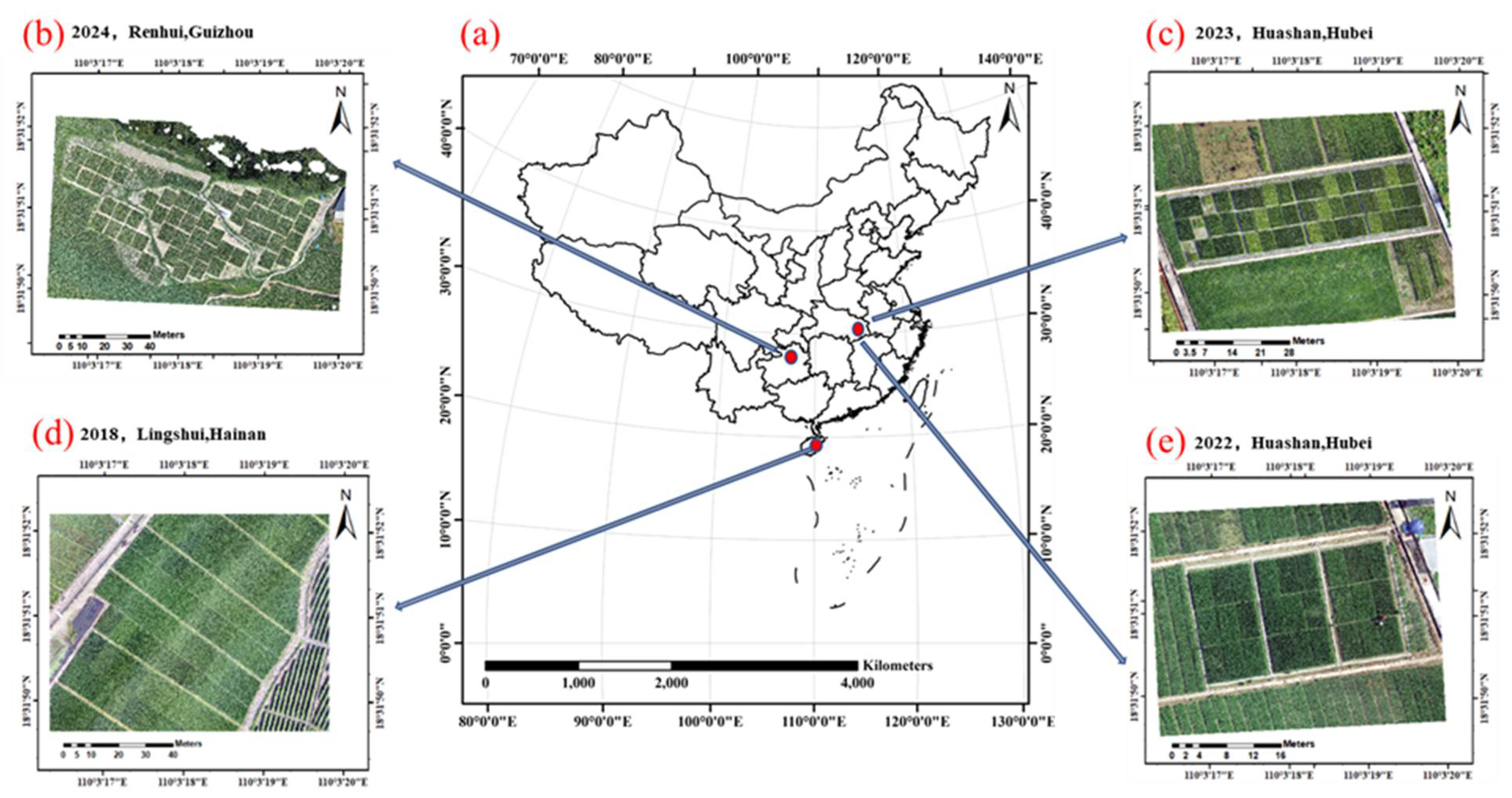
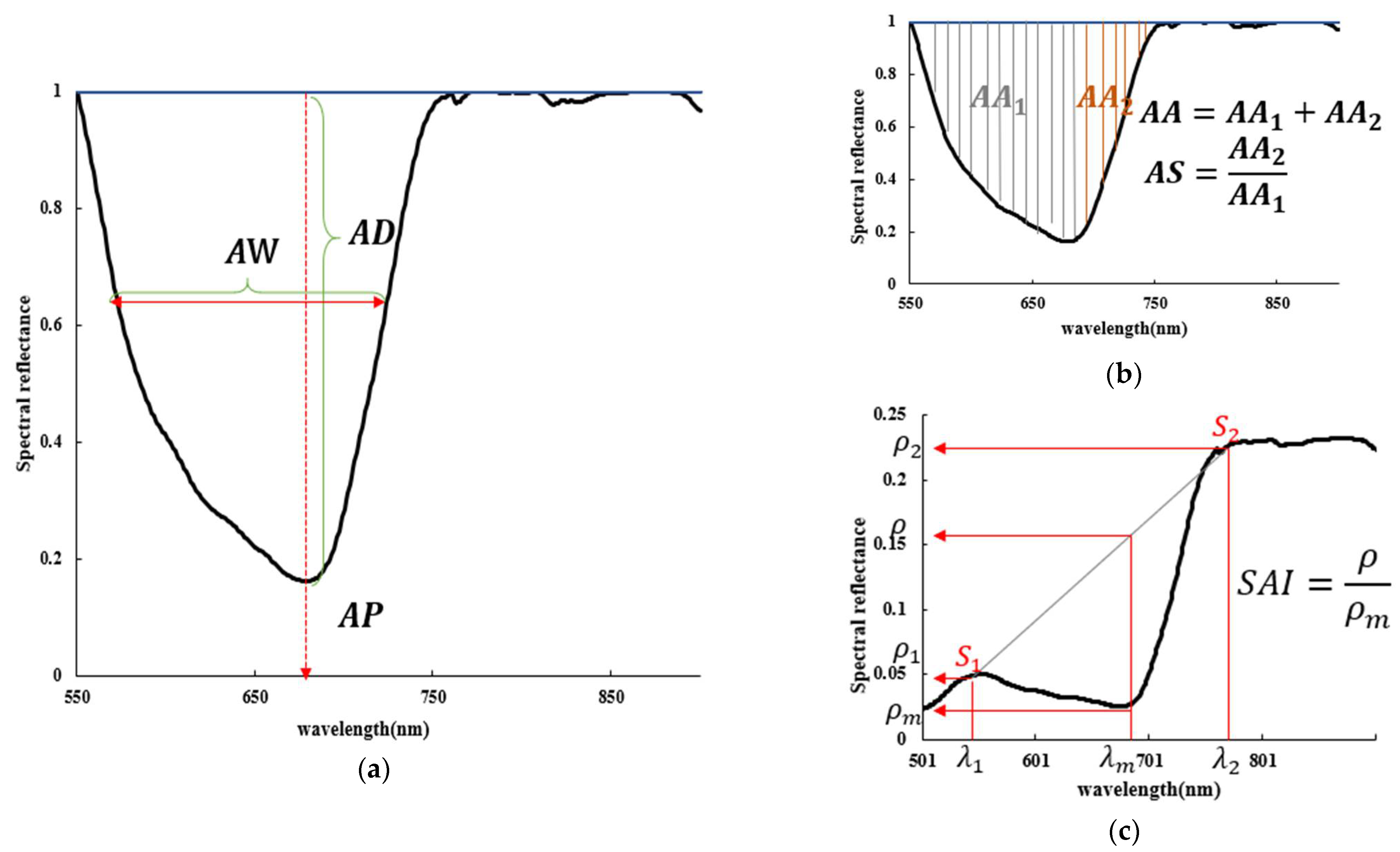
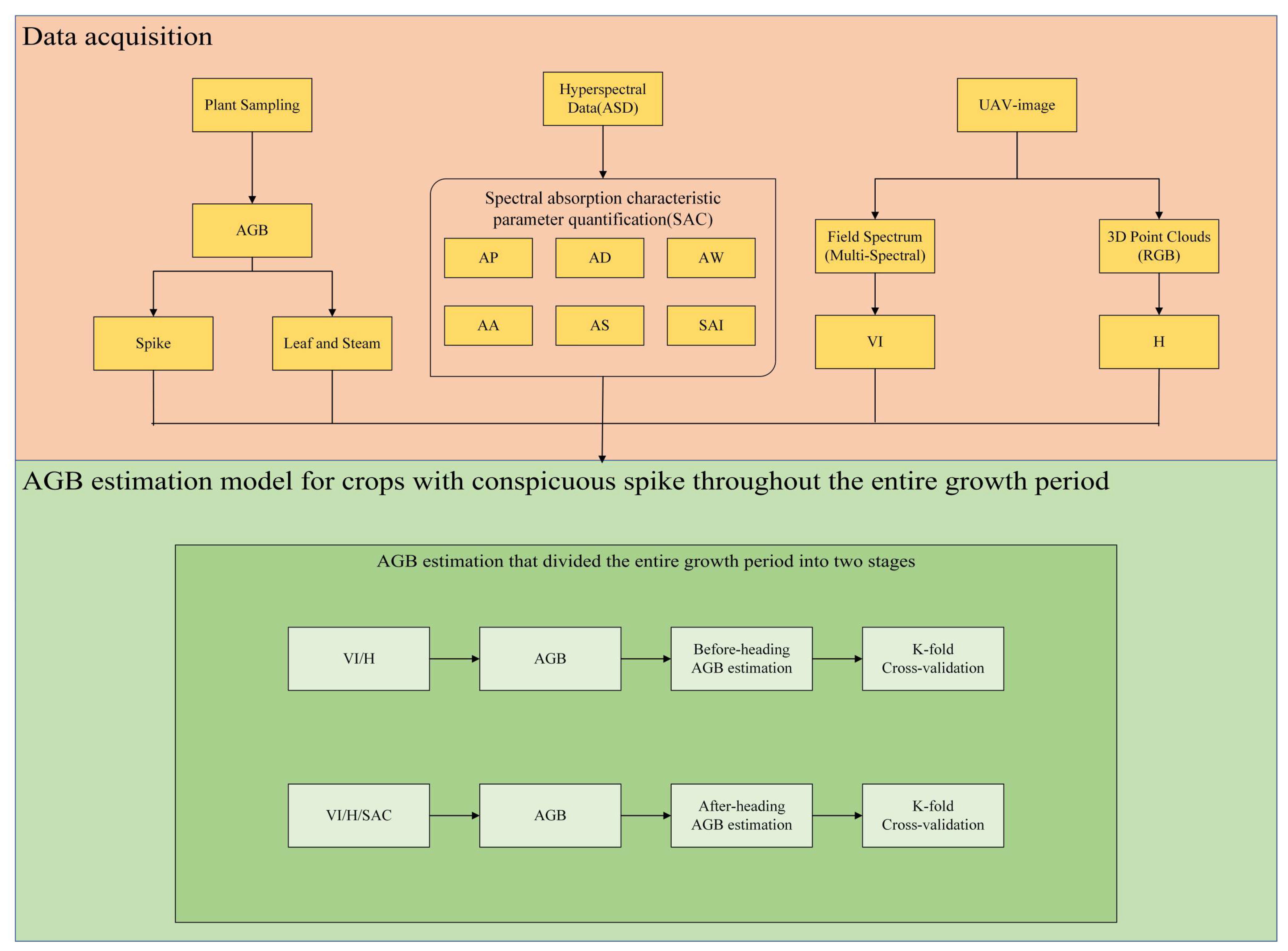
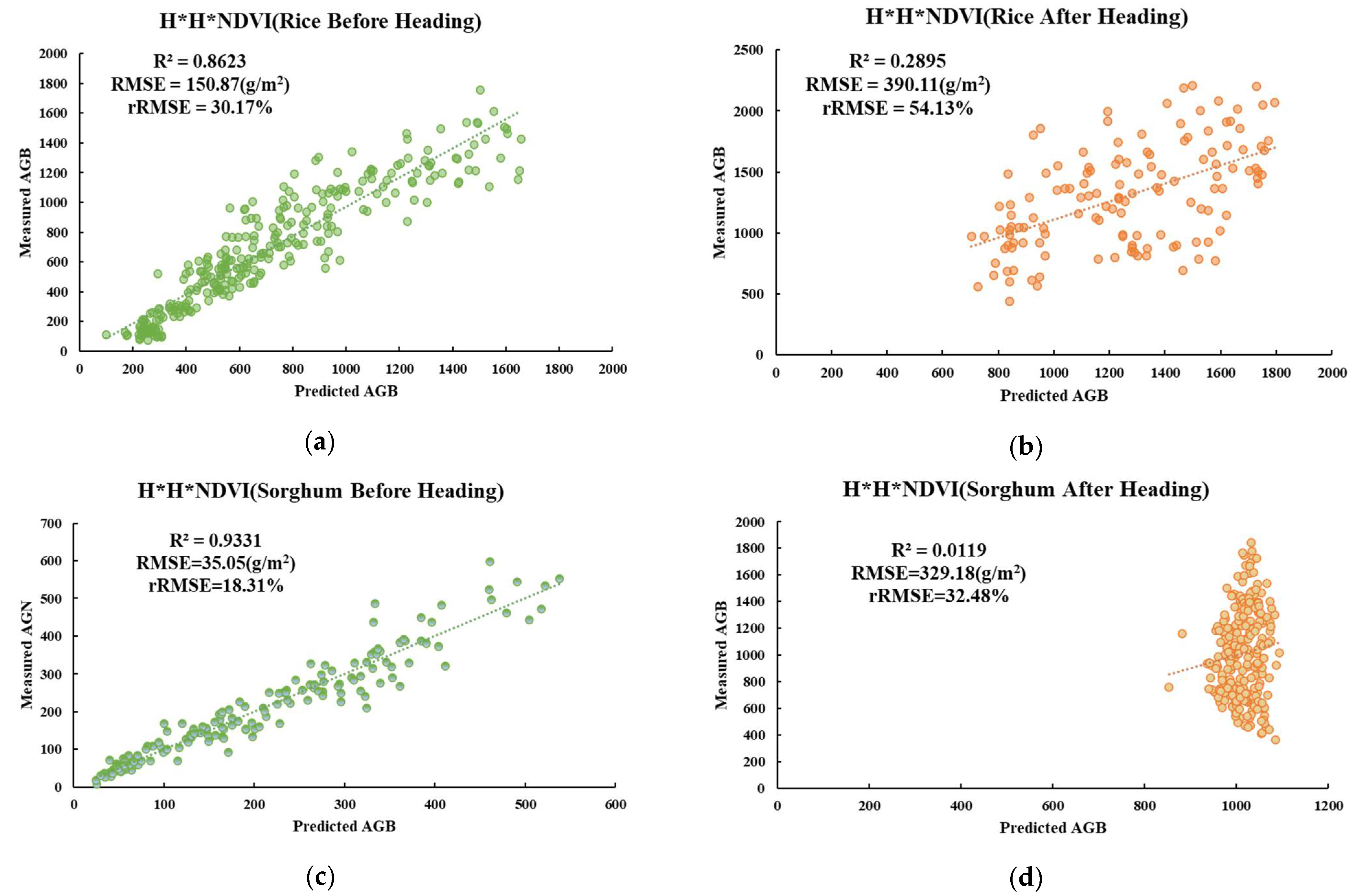
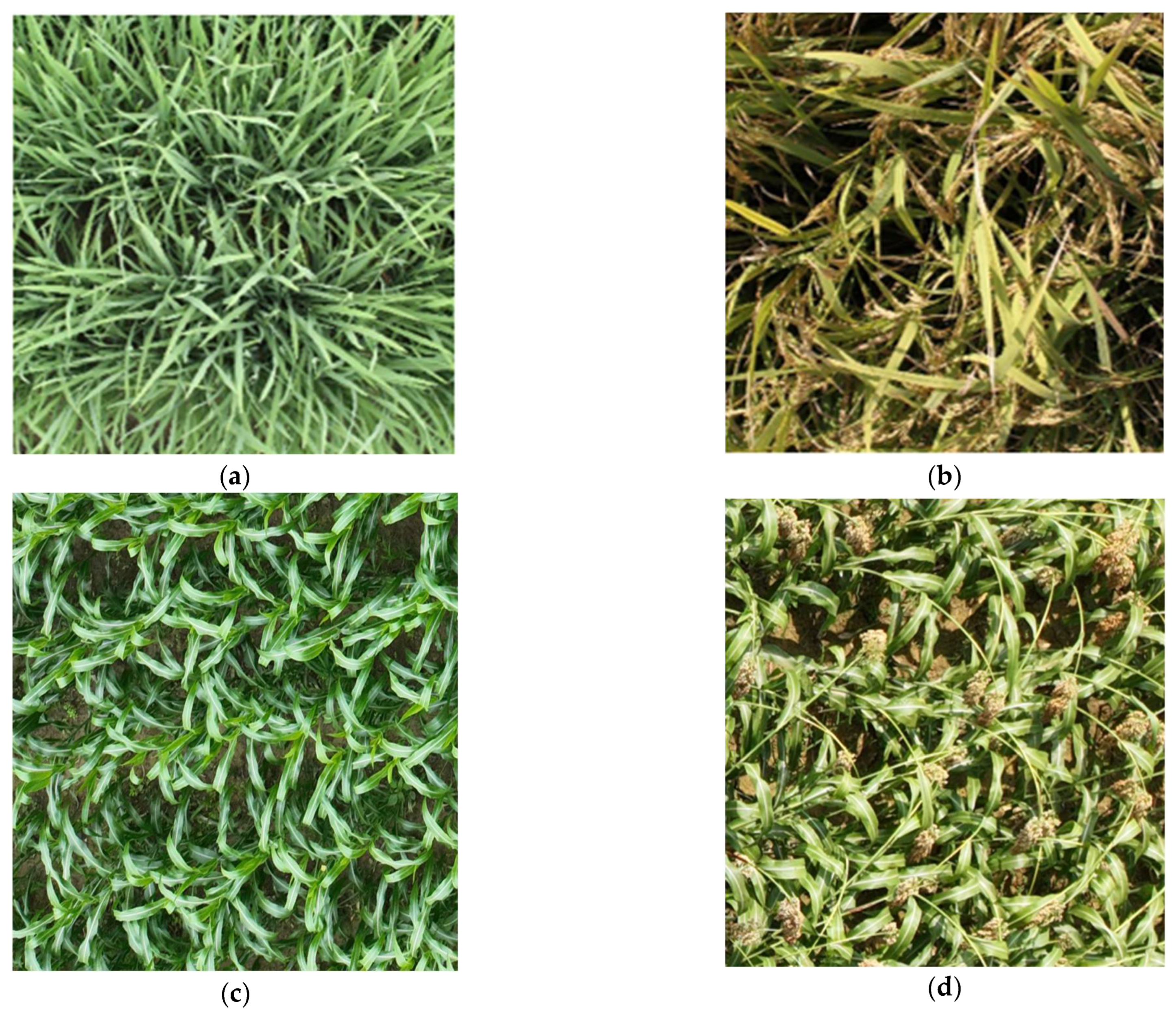

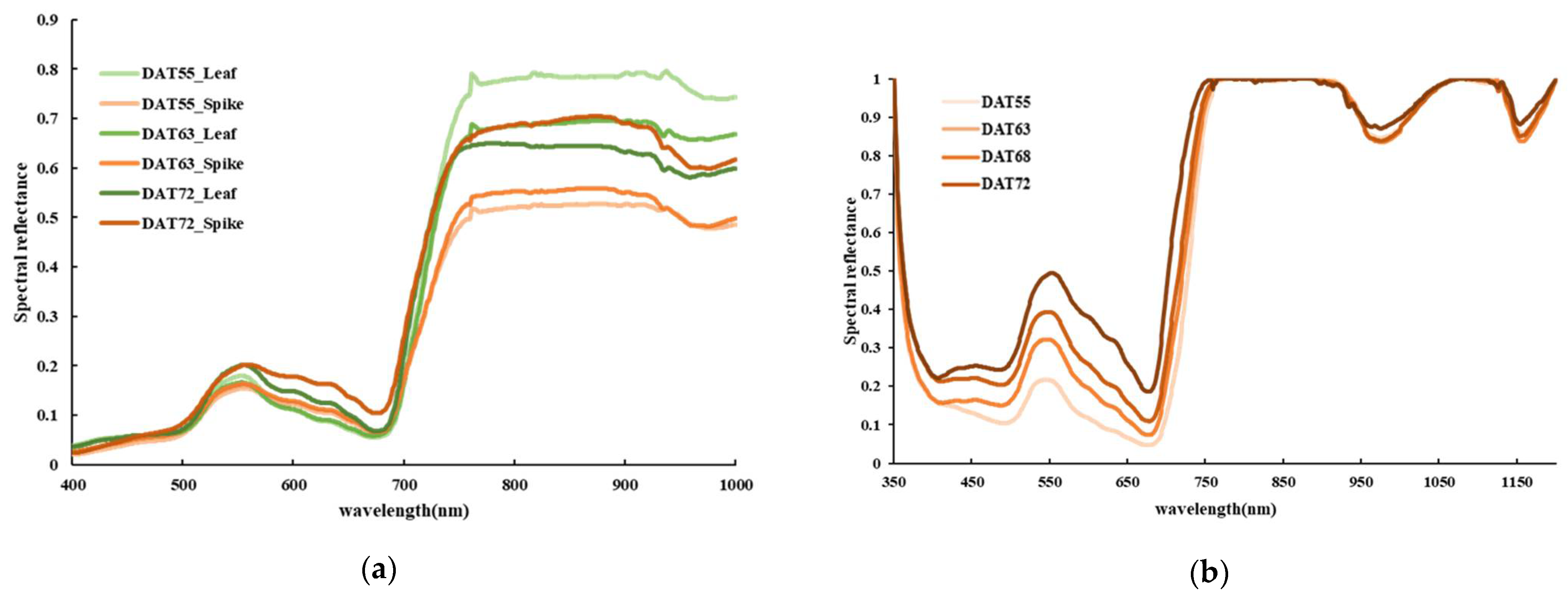

| Features | Description | Equation |
|---|---|---|
| NDVI [63] | Normalized difference vegetation index | |
| EVI2 [64] | Two-band enhanced vegetation index | |
| NDRE [65] | Normalized difference red-edge vegetation index | |
| OSAVI [66] | Optimized soil adjusted vegetation index |
| Features | Description | Equation |
|---|---|---|
| RAA | Ratio absorption area | |
| RAW | Ratio absorption width | |
| RAD | Ratio absorption depth | |
| DSAI | Difference spectral absorption index | |
| NDSAI | Normalized difference spectral absorption index | |
| RSAI | Ratio spectral absorption index |
| Model | Stage | R2 | RMSE (g/m2) | rRMSE (%) |
|---|---|---|---|---|
| H2 × NDVI | Before heading | 0.86 | 150.87 | 30.17 |
| After heading | 0.26 | 390.11 | 54.13 | |
| H2 × EVI2 | Before heading | 0.82 | 177.71 | 35.54 |
| After heading | 0.32 | 388.82 | 53.98 | |
| H2 × NDRE | Before heading | 0.83 | 187.40 | 37.48 |
| After heading | 0.15 | 467.73 | 62.90 | |
| H2 × OSAVI | Before heading | 0.85 | 155.47 | 31.10 |
| After heading | 0.21 | 407.65 | 56.12 |
| Model | Stage | R2 | RMSE (g/m2) | rRMSE(%) |
|---|---|---|---|---|
| H2 × NDVI | Before heading | 0.93 | 35.05 | 18.31 |
| After heading | 0.01 | 329.18 | 36.45 | |
| H2 × EVI2 | Before heading | 0.93 | 75.86 | 39.64 |
| After heading | 0.07 | 320.02 | 35.57 | |
| H2 × NDRE | Before heading | 0.92 | 37.37 | 19.53 |
| After heading | 0.09 | 315.93 | 34.17 | |
| H2 × OSAVI | Before heading | 0.92 | 37.29 | 19.49 |
| After heading | 0.11 | 313.15 | 33.89 |
| Features | R2 (AGB_Leaf+Stem) | R2 (AGB_Spike) |
|---|---|---|
| H2 × NDVI | 0.5587 | 0.0034 |
| H2 × EVI2 | 0.5663 | 0.0151 |
| H2 × NDRE | 0.5517 | 0.0749 |
| H2 × OSAVI | 0.5078 | 0.0019 |
| Features | R2 (AGB_Spike) |
| RAA | 0.2059 |
| RAW | 0.1688 |
| RAD | 0.2649 |
| DSAI | 0.0624 |
| NDSAI | 0.5363 |
| RSAI | 0.6152 |
| Model | R2 (Training Set) | RMSE (g/m2) (Training Set) | R2 (Test Set) | RMSE (g/m2) (Test Set) |
|---|---|---|---|---|
| Random Forest Regression | 0.93 | 201.34 | 0.82 | 269.56 |
| Support Vector Regression | 0.78 | 392.91 | 0.78 | 394.70 |
| Multiple Linear Regression | 0.89 | 260.58 | 0.89 | 262.86 |
| Crop | Stage | Model |
|---|---|---|
| Rice | Before heading | AGB = 1412.1 × H2 × NDVI + 75.93 |
| Rice | After heading | AGB = 931.26 × H2 × NDVI − 595.08 × RSAI + 1845.64 |
| Sorghum | Before heading | AGB = 113.46 × H2 × NDVI + 9.01 |
| Sorghum | After heading | AGB = 59.921 × H2 × NDVI − 343.5 × RSAI + 1488.08 |
| Model | R2 (Training Set) | RMSE (g/m2) (Training Set) | R2 (Test Set) | RMSE (g/m2) (Test Set) |
|---|---|---|---|---|
| NDVI | 0.08 | 455.80 | 0.04 | 461.47 |
| H2 × NDVI | 0.53 | 390.11 | 0.51 | 391.91 |
| RSAI | 0.72 | 307.89 | 0.70 | 309.76 |
| Multiple Linear Regression (H2 × NDVI, RSAI) | 0.89 | 260.58 | 0.89 | 262.86 |
| Model | R2 | RMSE (g/m2) | rRMSE (%) |
|---|---|---|---|
| H2 × NDVI | 0.65 | 294.68 | 35.32 |
| H2 × EVI2 | 0.64 | 298.60 | 36.67 |
| H2 × NDRE | 0.63 | 306.76 | 37.48 |
| H2 × OSAVI | 0.63 | 298.21 | 36.62 |
| f(H2 × NDVI, RSAI) | 0.88 | 189.06 | 20.13 |
| Model | R2 | RMSE (g/m2) | rRMSE (%) |
|---|---|---|---|
| H2 × NDVI | 0.63 | 296.49 | 42.68 |
| H2 × EVI2 | 0.48 | 357.28 | 51.43 |
| H2 × NDRE | 0.44 | 367.89 | 52.95 |
| H2 × OSAVI | 0.41 | 379.10 | 54.57 |
| f(H2 × NDVI, RSAI) | 0.96 | 89.46 | 14.97 |
Disclaimer/Publisher’s Note: The statements, opinions and data contained in all publications are solely those of the individual author(s) and contributor(s) and not of MDPI and/or the editor(s). MDPI and/or the editor(s) disclaim responsibility for any injury to people or property resulting from any ideas, methods, instructions or products referred to in the content. |
© 2025 by the authors. Licensee MDPI, Basel, Switzerland. This article is an open access article distributed under the terms and conditions of the Creative Commons Attribution (CC BY) license (https://creativecommons.org/licenses/by/4.0/).
Share and Cite
Zhang, Q.; Gong, Y.; Chen, Y.; Huang, Y.; Wang, T.; Zhang, S.; Wang, M.; Peng, Y.; Jiang, F.; Yang, F.; et al. Remote Estimation of Above-Ground Biomass Throughout the Entire Growth Period for Crops with Conspicuous Spikes. Remote Sens. 2025, 17, 2067. https://doi.org/10.3390/rs17122067
Zhang Q, Gong Y, Chen Y, Huang Y, Wang T, Zhang S, Wang M, Peng Y, Jiang F, Yang F, et al. Remote Estimation of Above-Ground Biomass Throughout the Entire Growth Period for Crops with Conspicuous Spikes. Remote Sensing. 2025; 17(12):2067. https://doi.org/10.3390/rs17122067
Chicago/Turabian StyleZhang, Qiaoling, Yan Gong, Yubin Chen, Yalan Huang, Tingfan Wang, Siyu Zhang, Minzi Wang, Yi Peng, Feng Jiang, Fan Yang, and et al. 2025. "Remote Estimation of Above-Ground Biomass Throughout the Entire Growth Period for Crops with Conspicuous Spikes" Remote Sensing 17, no. 12: 2067. https://doi.org/10.3390/rs17122067
APA StyleZhang, Q., Gong, Y., Chen, Y., Huang, Y., Wang, T., Zhang, S., Wang, M., Peng, Y., Jiang, F., Yang, F., & Wang, X. (2025). Remote Estimation of Above-Ground Biomass Throughout the Entire Growth Period for Crops with Conspicuous Spikes. Remote Sensing, 17(12), 2067. https://doi.org/10.3390/rs17122067







